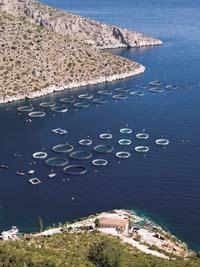Aquaculture, a growing sector
Situation in the world

Almost half of the fish currently consumed in the world comes from aquaculture (45%) and is expected to reach 50% in 2015 (FAO, 2008). Annual aquaculture production amounts to 60 million tons, with an average annual activity growth of 8% since the 1950s. It is therefore the fastest growing sector in the fishing industry and the most emerging food production sector in the world. Thus, for example, those associated with meat production have a growth of about 2%. Aquaculture is mainly concentrated in Asia and, specifically, in China, where more than 67% of the fish produced in the world is produced (FAO, 2007).
Advances in aquatic production technologies have contributed to the development of aquaculture in the world. The success of modern aquaculture has been based basically on three aspects: advances in reproductive control of species, knowledge of biology and the development of specific foods.
According to FAO data, 70% of international fisheries are exploited more than enough and the quantities that are fished have risen, most commercial species cannot be exceeded. Therefore, increased consumption of marine products should be based on aquaculture, becoming an important food source. In particular, FAO statistical models have announced that demand for fish by 2030 will be 183 tons. And for this demand to be met, annual aquaculture production will have to increase by 40 million tons.
Situation in the ACBC
In the Autonomous Community of the Basque Country, aquaculture has developed so far very little. This alone accounts for 1.2% of community fisheries production and 0.2% of the volume of aquaculture in Spain. The scarce development is due, among other factors, to the strong competition between the activities used by the coast (conservation, tourism, beaches, residence...), to the scarcity of land available on the coast, to the characteristics of the sea and of the time, to the growth technologies available so far, to the strong cultural roots of the maritime sector and of commercial fishing, to the export/import ratios of products, and to the absence of critical mass and aquaculture.
However, it is a booming sector, with a high capacity for growth in the ACBC, which gives us opportunities to undertake aquaculture activities. Aquaculture can be an activity that complements the extractive fishing sector, since the first is limited and can descend. Consequently, aquaculture could also serve to provide employment to people who have previously worked in the extractive sector. In addition, the development of new activities will increase the demand of the auxiliary industry that these require: manufacture of components, consultancy, maintenance of facilities, production of food adapted to food needs, etc.
Since 2008 the Master Plan for Aquaculture in the ACBC for the period 2008-2013 is underway, which aims to provide the necessary guidelines for the development of aquaculture. This plan has analyzed and collected the main competitive species, the techniques to be used, the lines of research to follow, the necessary infrastructures, etc.
On the other hand, technologies have been developed adapted to the needs of the territories that, like the Basque Country, have little chance of dedicating themselves to aquaculture. Currently there are different technologies on the market - aquaculture production systems - that can be located even far from the coast, using much smaller areas to offer the same production rate and adaptable to the characteristics of the Cantabrian Sea. This would also allow us to produce offshore.
In the case of ACBC, the growth of high value-added species is essential to be competitive and differentiate them from other countries and regions competing for quantity. In this sense, there are more and more species that can develop the entire biological cycle in research centers and that will allow to grow at an industrial level.
Another advantage of the ACBC is its capacity to transform cultivated species into aquaculture through the canning industry and/or fish wholesalers. The development of aquaculture will provide a stable raw material to fish wholesalers and the canning industry, ensuring a higher value-added product (packaging, filleting...) and stability to the canning industry, which is now almost conditioned by the fluctuations in the extractive sector.
Therefore, the production of fish through aquaculture will allow us to reduce dependence on food production and possess us more. It could also generate the possibility of exporting species of high added value and make the CAPV more competitive. In this way we are working various institutions of research, training, entrepreneurship and business creation, together with the administration, to accelerate the development of aquaculture in our country.
Buletina
Bidali zure helbide elektronikoa eta jaso asteroko buletina zure sarrera-ontzian











